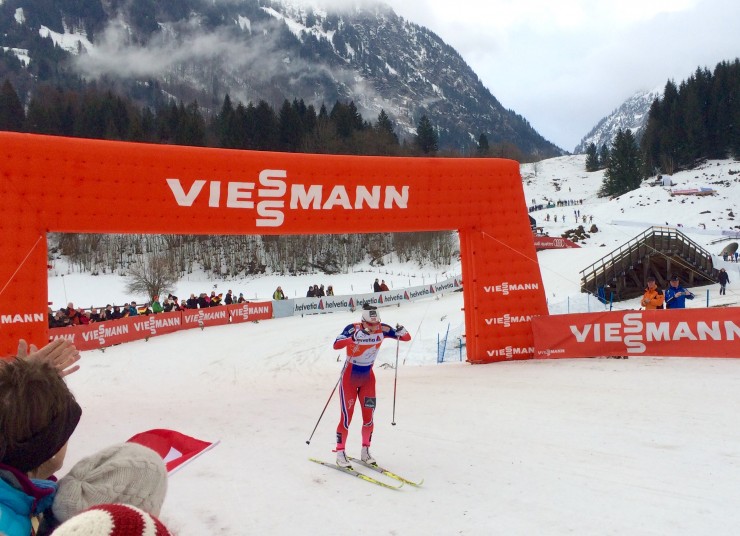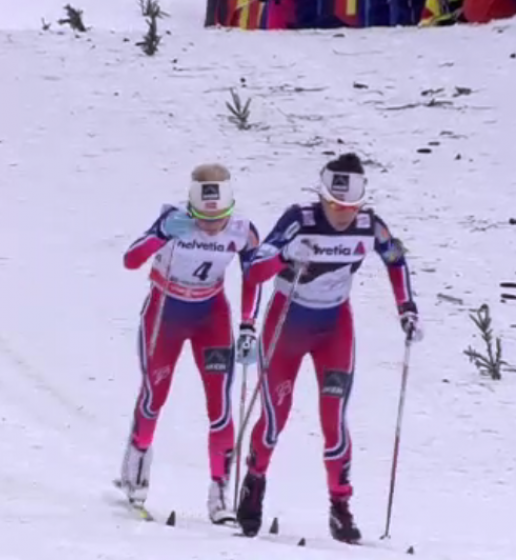
The FIS Cross Country World Cup season has already been a tour de force for Norway, but the country’s juggernaut women’s squad is turning the Tour de Ski into another one, too.
Marit Bjørgen has been the leader of the team for almost a decade. Every year or two, a new teammate breaks onto the scene and threatens to steal the limelight. Over and over again, it has been Therese Johaug, upping her game and looking like she just might outdo Bjørgen – or in the sprints, any one of a number of women from Maiken Caspersen Falla to Celine Brun-Lie and Ingvild Flugstad Østberg had shown their dominance.

This season, it looked like Johaug might have added the final tool to complete her arsenal, which was nearly unbeatable classic skiing. In early season racing, she topped 34-year-old Bjørgen in 10-kilometer classic races or else pushed her to the very limit, as she did in the World Cup pursuit in Lillehammer.
But here’s the thing about Bjørgen: just when you think that the rest of the world might have caught up, she accelerates again and reminds you why she’s top dog.
That was certainly the case in Sunday’s 10 k classic pursuit in Oberstdorf, Germany, the second stage of the Tour. Bjørgen started with a 15-second lead on teammate Heidi Weng, who has developed into an all-around threat in the last two seasons. Johaug, starting in fourth place, quickly caught Weng and the two worked together to chase down their veteran teammate.
Bjørgen had talked all week about what a threat Johaug posed and how difficult it would be to hold her off in the classic pursuit with such a small lead. But all of that went out the window once she left the start gate. Over the first two kilometers, Bjørgen extended her lead to 23 seconds. Then 35 seconds. By the time she finished, despite a furious pace from the chasers, she was in front by a whopping 56 seconds.
“I decided to go my own race and not worry so much about the competition,” Bjørgen told Norwegian broadcaster NRK. “It went very well. The shape is good, the skis were very good, so I’m very happy. I heard that the others struggled to keep up. I had amazing skiing so praise to the guys in the wax bus.”

Meanwhile, Weng and Johaug staged quite the battle of their own. The two diminuitive Norwegians were in almost perfect synchrony as they hit Oberstdorf’s big climbs. But even early on, their were hints of dissonance that showed they were seriously competing against one another, not just out for another training ski.
Weng cut Johaug off while switching tracks. Johaug did the same. They used the downhills to slingshot past each other and tried to gain every advantage, not just on the rest of the field, but in the fight for second place.
“It was a heavy day,” Johaug told NRK, according to a translation. “I couldn’t go so easily on the uphills and I noticed that I was missing [the kick] sometimes.”
Johaug managed to stay in the lead up the hill the final time, despite being forced out of the tracks and into a few strides of herringbone – Weng had the superior wax. Johaug had a slight lead going over the top, but with astute downhill tactics, Weng was able to gradually draw closer and closer.
By the time they hit the flat coming into the stadium, Weng threw in a few furious double poles and drew even with her teammate. Johaug may be the reigning Tour de Ski champion, but Weng outsprinted her down the long finishing straight, leaving the distance specialist in the dust and gaining not only 0.4 seconds by the finish, but also 10 bonus seconds to Johaug’s five.
Johaug had been perhaps the favorite in the Tour de Ski coming into the start of racing, in part because of her dominance on the final climb up the Alpe Cermis. Bjørgen had estimated that she would need a minute on Johaug before the climb to win the whole race.
There’s still four more races in between, but with bonus seconds on top of the 56-second span from the pursuit, Bjørgen now has that minute.
“I think Bjørgen can do it here,” Norwegian national team coach Egil Kristiansen told NRK. “She is actually not too bad on the uphill uphill when she has a good day, so I think certainly there are opportunities for Marit.”
As for Johaug, her perspective on the Tour has changed.
“The distance until Marit is very large,” she said. “Maybe a little too big. I think I must have some luck to win the Tour now.”
Johaug and Weng, too, developed a big lead on the rest of the field. The battle for fourth place was intense, with Justyna Kowalczyk of Poland, Sadie Bjornsen of the United States, Østberg , and Nicole Fessel of Germany leading over the first five or six kilometers.
But by the final climb, two Swedes had clawed their way to the front of the pack with good wax and flawless technique. 21-year-old Stina Nilsson, starting 20 seconds out of fourth place in 23rd at the beginning of the day, skied an aggressive downhill and came into the finish first of the chasers.
“I am very pleased with the entire race,” Nilsson told Sweden’s SVT television. “It was just to follow along and climb with the pack. I was very calm.”
With this form, Nilsson should be a major threat in the sprint race coming up in Val Müstair, Switzerland, at the next stage of the Tour.
Four seconds later came Fessel, then Kowalczyk, and then Sweden’s Emma Wiken, who had started the day even farther back in 32nd.
As had been the case in the prologue, the downhills cost Kowalczyk a lot of time – in this case, perhaps fourth place. Several times she went to the front of the chase pack on the climbs, and even sometimes developed small gaps, but was then engulfed by the pack on the downhills, which she took cautiously.
In fact, it took valuable seconds away from other skiers, too.
“I fell face on the first lap down the hill – I came up in back of a certain person who is not very good skiing downhill,” Østberg told Norway’s TV2. “I was dragged far into the ground… I lost a lot of momentum… I gave her apparently not enough meters. She should practice it. When someone snowplows on the downhills, it can create dangerous situations.”
Kowalczyk told TV2 she didn’t understand why Østberg would say that.
American Sadie Bjornsen ended the day in 14th, and teammate Liz Stephen was one place back in 15th.
Germany’s Claudia Nystad, a former Olympic gold medalist, crashed hard on one of the downhills after looking pale and less than her best on the climbs, and was unable to finish the race. Nystad was taken off the course on a stretcher on the back of a snowmobile.
Tour de Ski standings (PDF)
Chelsea Little
Chelsea Little is FasterSkier's Editor-At-Large. A former racer at Ford Sayre, Dartmouth College and the Craftsbury Green Racing Project, she is a PhD candidate in aquatic ecology in the @Altermatt_lab at Eawag, the Swiss Federal Institute of Aquatic Science and Technology in Zurich, Switzerland. You can follow her on twitter @ChelskiLittle.




One comment
shreddir
January 5, 2015 at 4:50 pm
Here’s a link to WeltFalilche Nachrichten German news site about Claudia’s trip to the hospital and subsequent Tour drop-out.
http://www.wn.de/Welt/Sport/Wintersport/Ski-Nordisch/1834827-Ski-nordisch-Sturz-auf-Eisplatte-Tour-de-Ski-Aus-fuer-Nystad
Apparently she got a nasty abrasion on her left temple along with left arm bruises when she whacked her head on an icy patch of the downhill section. She’s being treated for a mild concussion.